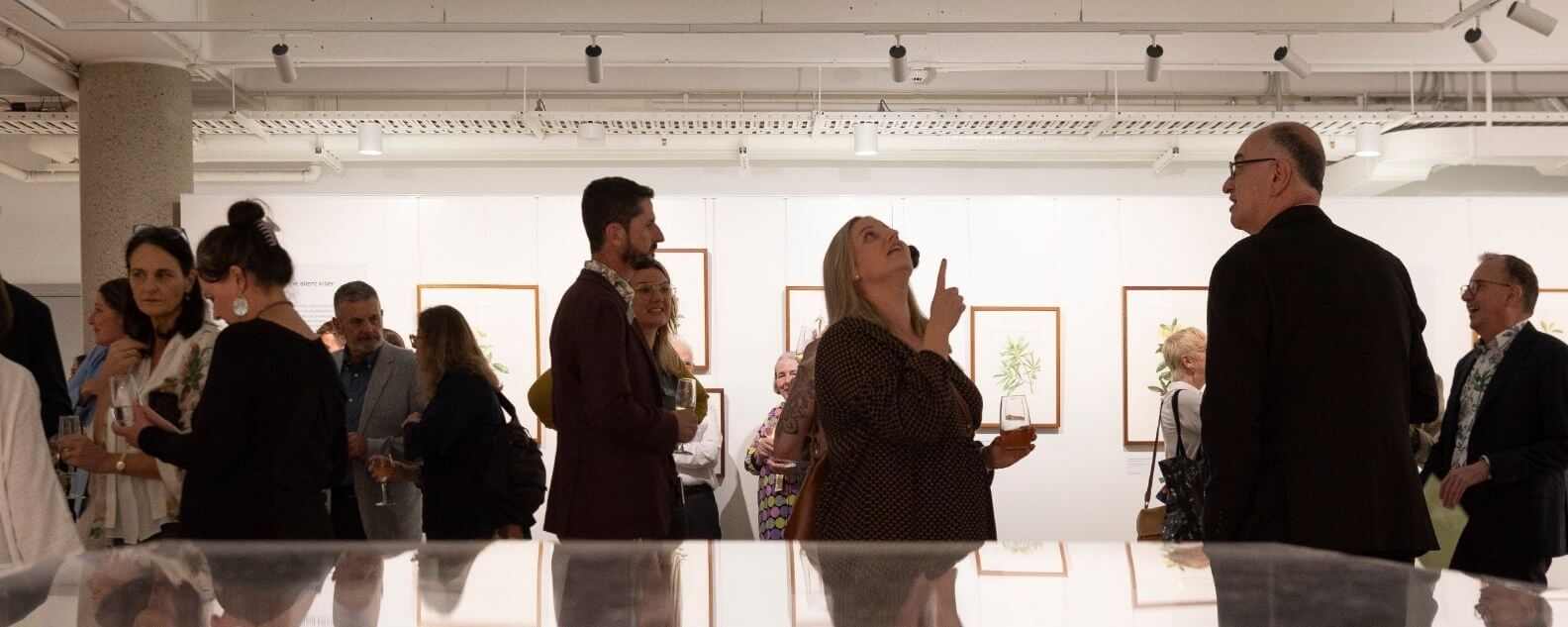Threatened rainforest species on show at inaugural exhibition
Botanical art is putting the impacts of climate change on plants in the spotlight following the opening of The Garden Gallery and new labs for the Research Centre for Ecosystem Resilience (ReCER) at the Royal Botanic Garden Sydney.

Contemporary conservation crisis
Botanic Gardens of Sydney’s vital work to protect and conserve plants through cutting-edge science and research inspired the Florilegium Society’s inaugural exhibition Rainforest Species at Risk in the transformed space inside the Robert Brown Building.
The remarkable botanical illustrations and paintings depict a contemporary crisis: the growing need to protect Australia’s fragile and important rainforest ecosystems amid the climate crisis.

The Florilegium Society was formed in 2005 to create a florilegium, a collection of contemporary botanical paintings of plants in the living collections of the Botanic Gardens of Sydney.
Major project complete
ReCER, working with the Australian PlantBank and horticulture teams, has helped guide the recovery of some of the species in the exhibition through ongoing conservation research.
The Garden Gallery and new ReCER labs are part of a $15 million renovation project following the relocation of the National Herbarium of New South Wales from the Robert Brown Building to a new state-of-the-art facility at the Australian Botanic Garden Mount Annan in 2022.

The Florilegium Society’s Rainforest Species at Risk is the inaugural exhibition in the newly renovated Robert Brown Building, which formerly housed the national herbarium before it moved to Mount Annan.
Discovering the power of plants
Professor Brett Summerell, Acting Chief Executive Botanic Gardens of Sydney, said the opening of The Garden Gallery and new ReCER labs marked a new chapter for the Royal Botanic Garden Sydney.
“Our vision for this space is to inspire more people to discover the power of plants and the inherent value they provide to our everyday lives,” Prof Summerell said.
"Plants often get neglected when it comes to environmental issues, but if we are going to combat climate change and biodiversity loss, we must start with saving plants.
“Several of the species depicted in the exhibition are under imminent risk of extinction from an invasive plant pathogen, Myrtle Rust, which is causing a pandemic in many species in the eucalypt family and require urgent assistance,” he said.
Professor Summerell said the transformation followed the momentous decision to move the entire Herbarium collection of over 1.4 million plant specimens to the Australian Botanic Garden Mount Annan between 2020 to 2022.
“Transforming the Robert Brown Building, creating the new Garden Gallery and building new science labs is the final step in that long process and we are proud to further enrich our visitors' experiences at the Royal Botanic Garden Sydney,” he said.

Above the new gallery space are science laboratories where researchers are trying to save some of the featured plants.
Science-based solutions
Acting Head of ReCER, Dr. Marlien van der Merwe, said it was a major milestone for her team of scientists that wouldn't have been possible without help from the Foundation and Friends of the Botanic Gardens.
“Our rapidly changing world requires rapidly evolving science-based solutions,” Dr van der Merwe said.
“And as climate change further threatens the integrity and long-term sustainability of rainforest ecosystems, understanding how rainforest communities are assembled, and why these assemblages change through time can guide rainforest preservation and restoration,” she said.
In a fusion of science and art, researchers working in the new science laboratories will be able to peer down below into the unique exhibition space.

(Left) Brachychiton acerifolius by Lauren Sahu-Khan (Right) Alphitonia excelsa by Angela Lober
Portraits of plants
Colleen Morris, curator for Rainforest Species at Risk from the Florilegium Society, said she was honored to oversee the inaugural exhibition at The Garden Gallery.
“All of the plants portrayed in 42 contemporary paintings in the Florilegium project and some of the 30 scientific illustrations in the exhibition grow in one of Botanic Gardens of Sydney’s three sites,” she said.
"The rainforest trees painted by the Florilegium artists for the exhibition include the rare, the common and the overlooked. All are at risk from habitat loss, climate change or pathogens such as myrtle rust, the silent killer of many Australian species,” she said.
Ms Morris said along with the Florilegium paintings, recent work by Botanic Gardens of Sydney’s botanical illustrators, Lesley Elkan and Catherine Wardrop, will be shown along with some of the original and exquisite early twentieth century illustrations of rainforest species by Margaret Flockton, the first botanical illustrator at the Royal Botanic Garden Sydney.
The Rainforest Species at Risk exhibition is on until May 5 at The Garden Gallery.